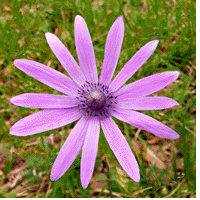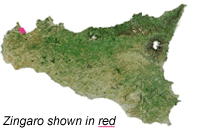...Best of Sicily presents... Best of Sicily Magazine. ... Dedicated to Sicilian art, culture, history, people, places and all things Sicilian. |
by Vincenzo Mormino | |||
Magazine Index Best of Sicily Arts & Culture Fashion Food & Wine History & Society About Us Travel Faqs Contact Map of Sicily
|
Lying in the shadow of Mount Còfano, the Zingaro is home to numerous species of flora and fauna. The star anemone, anemone hortensis (shown here), is just one of the many native plants, some of which are present in varieties or subspecies unique to Sicily. Sicilian sea lavenders (limonium flagellare and limonio todaroanum) grows
here. So do the strawflower (helichrysum rupestre), wild carnation (dianthus
rupicola), the Sicilian cornflower (centaurea ucriae), Sicilian wild cabbage
(both brassica bivoniana and brassica drepanensis), Sicilian hawkweed (hieracium
cophanense), giant spring sandwort (minuartia verna grandiflora), lithodora
(lithodora rosmarinifolia), bush morning glory (convolvulus cneorum), wild
crocus (romulea linaresii), several native Sicilian orchids and irises,
and others such as dwarf fan palms (chamaerops humilis). A number of birds breed or feed here. A partial list of some forty species includes Bonelli's eagle, the Mediterranean peregrine falcon, several owl and hawk species and the Sicilian rock partridge. A few hedgehogs and weasels live here too. And eight species of bat and all kinds of butterflies. The Zingaro is a true sanctuary. Trekking is permitted, with the greatest number of visitors arriving during the summer months. Germans predominate among the foreign hikers. Uzzo Cave bears traces of the earliest human presence in western Sicily. The Zingaro is one of the relatively few parts of the Sicilian coast lacking a paved road, despite numerous political efforts to construct one. Likewise, there are few buildings in the park. The waters off the Zingaro are excellent for scuba diving. There is a visitors' centre but Scopello, with its baglio, or "bailey" (in Sicily a fortified structure built around a walled courtyard), is a focal point for those coming to the Zingaro. Several stony islets and two medieval watch towers add to Scopello's atmosphere. Scopello also has a small beach. The Zingaro is about an hour's drive from Palermo, and closer to Trapani. It is possible to rent a villa or cottage in the immediate vicinity. About the Author: Vincenzo Mormino has written about wildlife and nature for Best of Sicily and hard-copy publications. | ||
Top of Page |
 In one form or another, grasslands and bushlands abound in Sicily, but the
truly wild ones are rather rare. The Lo Zingaro Nature Reserve is one of
the few protected natural grasslands in Sicily. Located along Sicily's Tyrrhenian
coast between San Vito lo Capo and Castellammare del Golfo near the hamlet
of Scopello, the Zingaro covers sixteen hundred hectares around Mount Speziale
and includes several grottos along the rocky coast.
In one form or another, grasslands and bushlands abound in Sicily, but the
truly wild ones are rather rare. The Lo Zingaro Nature Reserve is one of
the few protected natural grasslands in Sicily. Located along Sicily's Tyrrhenian
coast between San Vito lo Capo and Castellammare del Golfo near the hamlet
of Scopello, the Zingaro covers sixteen hundred hectares around Mount Speziale
and includes several grottos along the rocky coast.